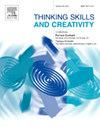Markers of creative potential in girls and boys during mathematics and language lessons: An observational study
IF 4.5
2区 教育学
Q1 Social Sciences
引用次数: 0
Abstract
This study explores behaviors associated with creative potential (i.e., creative potential markers) among high school students in mathematics and language lessons, with an emphasis on gender differences. The research involved 176 high school students and 12 teachers from six schools - from various regions of Poland. Using direct observation and a structured observation protocol, the study identified four key types of creative potential markers: (1) questioning others’ views and generating alternative solutions, (2) public presentation of creative products, (3) public presentation of personal views, and (4) demonstrating openness to new information and perspectives. The results revealed that students’ behaviors associated with the public presentation of personal views were less frequently observed in mathematics lessons than in language lessons. No statistically significant differences were found in the frequency of other types of creative potential markers between mathematics and language lessons. Boys demonstrated greater openness to new information and perspectives, but only in mathematics. No statistically significant differences were observed in the frequency of creative potential markers based on students’ gender in language lessons. These findings suggest that educational practices should be adapted to foster creativity across different subjects and address gender-specific tendencies in creative expression.
数学和语言课程中女孩和男孩创造潜力的标记:一项观察性研究
本研究探讨了高中学生在数学和语言课程中与创造潜力(即创造潜力标记)相关的行为,并强调了性别差异。这项研究涉及来自波兰不同地区的6所学校的176名高中生和12名教师。通过直接观察和结构化观察协议,该研究确定了四种关键类型的创意潜力标记:(1)质疑他人的观点并产生替代解决方案,(2)公开展示创意产品,(3)公开展示个人观点,(4)对新信息和新观点持开放态度。结果显示,与语言课相比,学生在数学课上公开表达个人观点的行为较少。在数学和语言课程之间,其他类型的创造性潜力标记的频率没有统计学上的显著差异。男孩表现出对新信息和新观点更开放的态度,但仅限于数学。在语言教学中,基于学生性别的创造潜能标记出现的频率差异无统计学意义。这些发现表明,应该调整教育实践,以促进不同学科的创造力,并解决创造性表达中的性别特定倾向。
本文章由计算机程序翻译,如有差异,请以英文原文为准。
求助全文
约1分钟内获得全文
求助全文
来源期刊

Thinking Skills and Creativity
EDUCATION & EDUCATIONAL RESEARCH-
CiteScore
6.40
自引率
16.20%
发文量
172
审稿时长
76 days
期刊介绍:
Thinking Skills and Creativity is a new journal providing a peer-reviewed forum for communication and debate for the community of researchers interested in teaching for thinking and creativity. Papers may represent a variety of theoretical perspectives and methodological approaches and may relate to any age level in a diversity of settings: formal and informal, education and work-based.
 求助内容:
求助内容: 应助结果提醒方式:
应助结果提醒方式:


